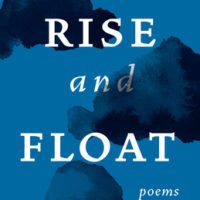Of time, J.W. Dunne, in 1934, writes that if
Time passes or grows or accumulates or expends itself or does anything whatsoever except stand rigid and changeless before a Time-fixed observer, there must be another Time which times that activity of, or along, the first Time, and another Time which times that second Time, and so on in an apparent series to infinity.
Brian Tierney’s poems, in their push against and into memory, appear to echo this argument. Time, then, is not simply the linear timelines we learned in 7th grade social studies. Rather, there exists different versions of Time, like a mirror reflecting another mirror, and Tierney’s debut collection, Rise and Float, selected by Randall Mann for the Jake Adam York Prize, leans closely into these.
Tierney begins Rise and Float with the poem “Migraine,” which asserts an ironic introductory denouement: “It starts at the end: the lights of cars / distorted to a burst.” The poem places the reader “In the exhausted fog //over Mars, PA, then Punxsutawney / and New Stanton,” then into other Pennsylvania small towns, “Eerie, or Breezewood.” A Pennsylvanian native myself, the running joke here is that the state consists of Philadelphia and Pittsburg with Kentucky in between (a joke which many a political map have verified). Here then, we begin the collection in a Pennsyltucky fog. The speaker of this poem pulls over, presumably due to his migraine, where
…otherworldly
filaments hang above a broke-open rodent
like a hammered pomegranate—its headuseless, even to birds. It hurts to look at…
Tierney’s description of “useless” roadkill is juxtaposed with a quick anecdote about his father, before death, pulling over his minivan to phone his family, “a faint red //fingertip print smeared on the dash.” The collection, then, opens with one of Tierney’s more narrative poems in which we have a scene and a setting, but which then spawns a memory in his speaker: a father. Which poses the question: What, actually, hurts to look at? As we learn, Tierney is a master of propelling mystery or perhaps what Keats would call “negative capability.”
Tierney continues a motif of decomposing fruit into the following poem, “Howard Johnson,” which contemplates four rotting pumpkins at the rural HoJos lobby, their “smiles decaying.” This image again recalls “your” cousin’s stroke. The pronoun you here holds immense significance in this poem, though we are never explicitly told who you is. However, the poem culminates: “You approach. Across the highway, a sign / reads What else is there? Isaiah 40:3. // The glossy paint sort of shines.” The Biblical allusion here, one might recognize from Godspell, “Prepare ye the way of the Lord,” which highlights the godlike importance of the poem’s second person pronoun.
I’m getting too close to the poems, but Tierney’s collection demands a closeness. To zoom out, not all poems in the collection deal with paternal grief, though Tierney’s father, a victim of cancer, looms throughout many. The collection, too, is dedicated to his parents. Dividing the book into five sections, the poet leads with a W.S. Merwin quote about what we can do with words: either “to tell / the lives of others / using distance as a lens,” or “when there is no distance / so that water / is looking at water.” Thus, we have a removed familial history oscillating against the poet’s own reflection. And where one poet might choose to provide a focus on the paternal grief itself, Tierney, instead chooses to explore the grief for what it is: a reaction to time and memory, where time is a social construct. Holes operate as a motif throughout this collection: the gaping hole of paternal loss, the speaker’s bulimic vomiting into the hole of a toilet to become “a little less each week,” and even, in my own Star Trek raised mind, the space time continuum of enigmatic black holes. In “Ideation” Tierney argues:
You avoid it, the hole. In a way, you are already inside it.
You’ve stared into the hole
through the thought of the hole. The way a tunnel is
if you don’t have headlights. It will not go all the wayto the other side. Not all at one time.
In “Time and Tide” the speaker recalls a dream of his mother praying to a saint who died of tuberculosis, comparing her cheeks to “Carrara pears / as hard as the tumor / on my father’s neck.” He ends the poem with an interrogative: “Is each keyhole smaller than the last?”
Tierney develops this thought further into the poem “Nothing Has Passed Between Us But Time,” a poem of four sonnets, all connected by the preceding sonnet’s imagery, which begins (where else?) on the New Jersey Turnpike, where a health care billboard spurs the speaker into memory: “the kind my father knew, // toward the end, as well as sick itself” which spawns further recall of his parents’ how-did-you-two-meet:
…in the city, where he met Mom
among veggies in stands, she says, when I ask, she
says the clerk said: please don’t bite the late tomatoes!
Here, tense shifting (usually a poetic craft no-no), occurs, but it occurs grammatically, and seamlessly, with clear intention. A memory spawns a memory spawns a memory. He met, she says. The memory lands on another signifier of time: the late tomatoes. The next sonnet of this series addresses the construct of time in the speaker’s ancestry, while the speaker’s mother continues to relay this memory:
She overheard her mother’s mother’s tongue, she thinks
lucanodialeto, which by then she had lost, same way I lost
the southern-Italian obsidian in my hair—see?
This mother is recalling a lost heritage, her “gray-white roots” serving as metaphor for the aging lineage, dependent on memory. The series moves back into the tristate area, in Paterson, where familial memory in this series, is fleeting and “leaves a sort of stain, a faint spilled wine.” The sequence culminates with a final sonnet, centering on the visual documents that preserve familial memory, and beginning on the conditional: “If I linger now. If I describe another photograph” then “it is because they have been waiting a long time / for the fall of my eyes.” Tierney’s personification of the ancestors in this photograph leads into the videography of his direct lineage:
I rewind again, again, a small resurrection:
Mom at thirty-six, in the hospital, un-kissing my father
as the first skin over my skull shrinks back
into the cradle of his hand
Noted here, is Tierney’s use of consonance, the use of the prefix “re-“ meaning not before, but again, thus allowing this argument of time, of the past specifically, as a nonlinear entity, to fully take its root. Noted, too, is Tierney’s use of the sonnet in octaves followed by sestets, his take on Petrarch, and by extension, his Italian lineage. I love this poem.
And there is a lot to love about this collection. In the poem “Wormhole,” for instance, Tierney, after contemplating the discomfort of a groaning house, until it finally quiets, continues this argument against our perceptions of time: “I became each minute, I became every direction at once // and fled from source and definite position.” He brings us back to his “mother in plaid widow slippers” and the “memorial flowers” they planted. Tierney doubles down against our social construct of time in his use of repetition: “when I was younger, not young,” then later, “I thought at the outset was wholeness, was not wholeness.” In both cues, Tierney is presenting us with abstracts that are both present and negated simultaneously. Much like the grief at the heart of this poem. Following this purposeful negation, Tierney’s strategic motif of the necropastoral—the roadkill, the skulls, the illness, the fruit decay—converses with this collection’s title. At the center of this grief, then, we are encouraged to both rise and to float, an argument of ascension, and if not the possibility of divinity, then, at the very least, transcendence.
If I could place Tierney within a tradition, I might call him part of the New New York School, except that I think that may have already existed, and in this case, the poems are starkly Pennsylvanian. However, Tierney’s eye for drawing abstraction at precisely the right cerebral moments, casting its line into the reader’s imaginative capability, and then drawing it back in to locate the emotional centerpieces of each poem, presents a delicate skill. In this way, his work certainly links him to the tradition of John Ashbery and Frank O’Hara. What a welcome addition.
***





